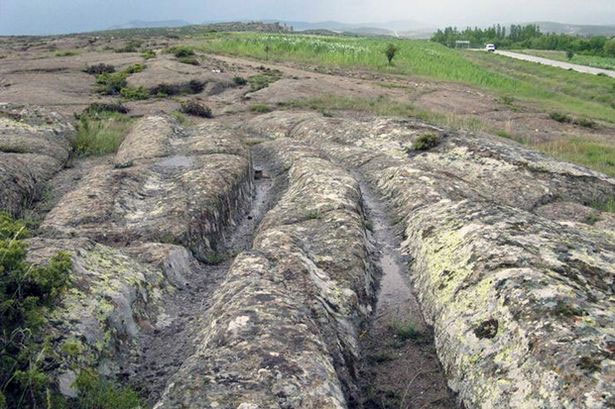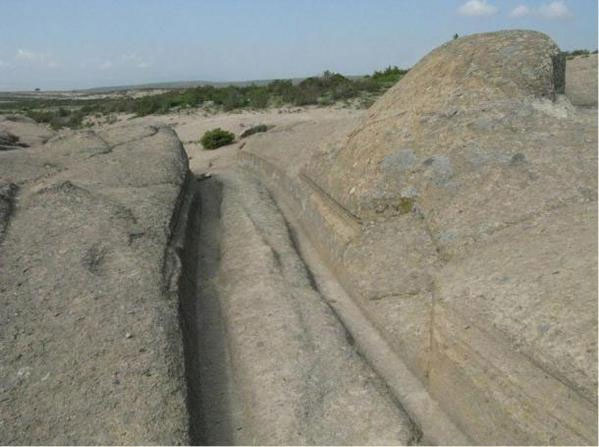Giant car traces of prehistoric times
A Russian scientist affirmed that the strange deep subsidence in the Phrygian valley, Turkey is a mark of civilization that appeared before humans.
Detecting strange deep subsidence in Phrygian valley
The one who made the controversial statement was the geologist, Dr. Alexander Koltypin, director of the Center for Natural Science Research at the Independent International University in Moscow, Russia. Koltypin and his colleagues back in August from a survey in Turkey's Anatolia region, where the ground overlapped subsidence trenches, described as "fossilized trenches feeding on volcanic rock terrain".
Previously, scholars said that the grooves formed through many historical periods.

Settlement tracks are said to be 'giant all terrain vehicles' on volcanic rock in Turkey.(Photo: Alexander Koltypin).
The first trenches are thought to appear in the Hittite Empire (1600-1178 BC). Over time, the roads deepened into soft rock after the continuous movement of the Phrygians, Greeks and Alexander the Great and his army. Finally, they became part of the Roman Empire's transport network, the Turkish magazine Culture Routes wrote.
However, after joining his colleagues in the field to study deep grooves, Koltypin concluded that this was the remnants of wheel tracks, but certainly not a light vehicle such as a carriage or a war. far code.
Instead, he argued that the sinking had to be "vehicles that crossed all the previously unknown terrain" , of enormous size and great weight, created. Koltypin identifies them as approximately 14 million years old and developed by a mysterious civilization before humans.

The deepest groove measures up to one meter, dating from 12-14 million years.(Photo: Alexander Koltypin).
"This area is covered by deep subsidence trenches formed millions of years ago, but not related to humans . " Koltypin said and affirmed the subsidence since prehistoric times, based on the analysis of fracture characteristics and observed weathering. "The method of determining the age of volcanic rocks has been carefully studied and proved its accuracy."
This scientist describes, the distance between the pair of grooves quite equal, equivalent to the distance between two wheels of modern cars. However, their settlement is much larger than the level that today's cars can create on the road. Measurements at the site show that the groove has a maximum depth of one meter. The inside surface of the trench also has many horizontal incisions, possibly a trace left by friction with the axis of ancient tanks.
Koltypin believes that the giant terrain wheels cut the groove deep into the rocky ground when it is still soft and moist thanks to their enormous weight.
"Then the subsidence and all the surrounding fossil surfaces, keeping the evidence intact to this day. Such cases are very common for geological circles, dinosaur footprints are also" said "natural" , Koltypin explained.
Koltypin is aware of his claims to be controversial. Traditional scholars will not mention this topic because it will "smash all their classic theories."
"I think we are seeing traces of a civilization that existed before human birth. Maybe these creatures of this prehistoric civilization are not the same as today , " Koltypin assumes. .

The large wheel tracks in the Malta Islands and the Mediterranean are also a mystery to the research community.Photo: Ancient Origins).
The equally mysterious deep grooves are also located in some other places on the earth, most notably in the Malta archipelago, located in the middle of the Mediterranean, and becoming one of the phenomena that confuses the scientific world. Some strange subsidence lines on the Misrah Ghar il-Kbir site, the Malta archipelago pierces the cliffs that rise out to the sea or intentionally reach the ocean. Who made these big wheel marks or why they appeared is still a mystery.
Like the mystery of the trenches in the Malta Islands, many questions revolve around the deep subsidence of the rocky ground in the Phrygian Valley that has yet to find a solution. The scientist Koltypin is continuing his research, but it takes some time before his conclusions contrary to the old concept are considered.
- Bac Kan: Detecting traces of prehistoric people in Ba Be
- 3 giant prehistoric monsters can exist today
- Close up of fossils of crocodiles, elephants, giant prehistoric birds
- Giant beasts that once dominated Australia in prehistoric times
- The prehistoric insects that make you
- Detecting traces of 'funeral funeral'
- Earth used to have a 10-meter-long worm
- Monsters that dominated the prehistoric world
- The implications of the prehistoric giant figures
- Believe it: This deep smoking cave was dug by giant creatures in ancient times
- Detecting traces of people near Con Moong cave
- Giant prehistoric beasts
 Discovered an ancient centipede fossil 99 million years old
Discovered an ancient centipede fossil 99 million years old Discovered bat-like dinosaurs in China
Discovered bat-like dinosaurs in China Discovered a 200-year-old bronze cannon of the coast
Discovered a 200-year-old bronze cannon of the coast Discover 305 million-year-old spider fossils
Discover 305 million-year-old spider fossils